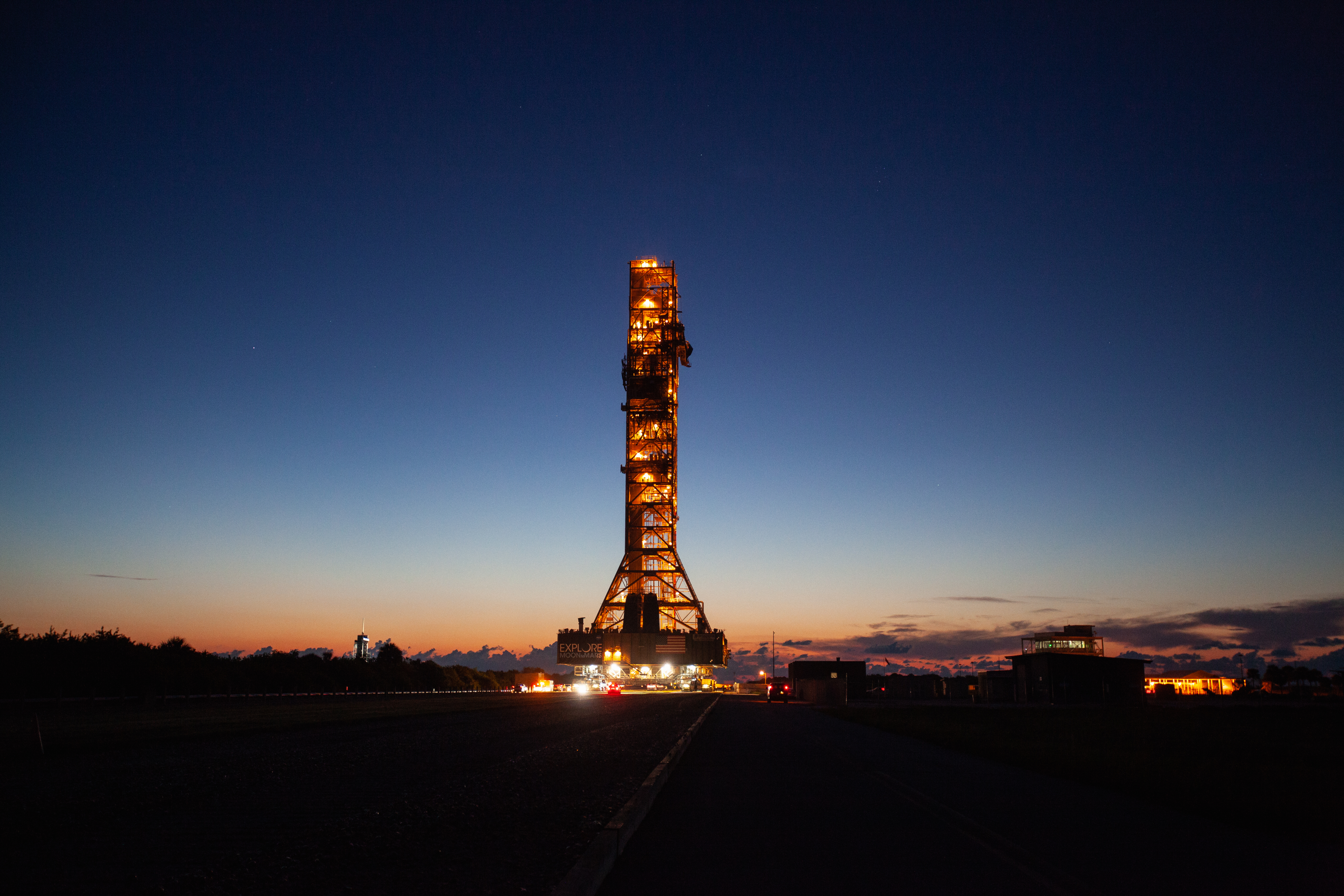NASA's Mighty Moon Launcher Moves to Rocket Pad for Solo Testing

NASA's lunar mobile launcher is one step closer to sending its first spacecraft to the moon.
The launcher is now in final testing for Artemis 1 — an uncrewed test trip around the moon of the Orion spacecraft slated for 2020 or so — after making its last solo trip to the Kennedy Space Center Launch Pad 39B on June 27. The launcher will remain at the pad for two months before going inside the nearby Vehicle Assembly Building (VAB) to join the Orion capsule and its rocket, called the Space Launch System (SLS).
One day, this same system could launch humans towards the moon. The Trump administration recently tasked NASA with landing humans there by 2024, and the agency is also planning a Gateway space station for future lunar missions. But first, engineers are putting the mobile launcher through a series of tests on the pad and in the VAB in preparation for these moon milestones.
Related: Can NASA Really Put Astronauts on the Moon in 2024?
"The mobile launcher has [already] gone through a series of critical tests in the VAB," Dan Florez, NASA test director with exploration ground systems at Kennedy, said in a statement. "We've conducted umbilical arm swing tests, environmental control system tests, hydraulic testing, nitrogen and helium testing and electrical tests to verify commands from the Launch Control Center are properly communicating with the ground support equipment and umbilicals."
Now that the launcher is at the pad, some of the forthcoming testing includes looking at the flow of water designed to suppress the sound waves from the SLS as it lifts off; otherwise, these waves could damage the SLS, Orion and the mobile launcher during ignition. Technicians will also examine the electrical and umbilical systems, as well as the propellant flow.
In addition, the team will swing three umbilical arms on the launcher at the same time in order to simulate what happens during launch. These umbilicals carry power and propulsion for the SLS, as well as air to purge the lines connecting to the 365-foot (111-meter) rocket.
Get the Space.com Newsletter
Breaking space news, the latest updates on rocket launches, skywatching events and more!
While the launcher is new, there are technological echoes of the Apollo moon program of the 1960s that landed the first humans on the moon 50 years ago this month, in July 1969.
The SLS launcher made the slow, 10-hour journey aboard the same crawler-transporter that moved the mighty Saturn V rocket to its launch pad for its moon missions. Pad 39B, where the unit is being tested, was also the departure site of the Apollo 10 mission that served as a dress rehearsal for the lunar landing. (The other moon-bound Apollo missions all launched from Pad 39A). And the VAB is the same location where moon rockets were put together five decades ago.
- Photos: Atop NASA's Huge Mobile Launch Tower
- In Photos: NASA's Kennedy Space Center Renovates Launch Pad 39B for Orion
- The Apollo 10 Mission: NASA's Lunar Landing Dress Rehearsal in Photos
Follow Elizabeth Howell on Twitter @howellspace. Follow us on Twitter @Spacedotcom and on Facebook.
Join our Space Forums to keep talking space on the latest missions, night sky and more! And if you have a news tip, correction or comment, let us know at: community@space.com.

Elizabeth Howell (she/her), Ph.D., was a staff writer in the spaceflight channel between 2022 and 2024 specializing in Canadian space news. She was contributing writer for Space.com for 10 years from 2012 to 2024. Elizabeth's reporting includes multiple exclusives with the White House, leading world coverage about a lost-and-found space tomato on the International Space Station, witnessing five human spaceflight launches on two continents, flying parabolic, working inside a spacesuit, and participating in a simulated Mars mission. Her latest book, "Why Am I Taller?" (ECW Press, 2022) is co-written with astronaut Dave Williams.









